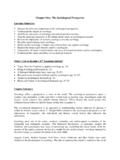Transcription of CERTIFICATE/DIPLOMA IN SCIENCE - OCR
1 OCR LEVEL 2 CAMBRIDGE TECHNICALCERTIFICATE/ diploma INSCIENCEHUMAN BEHAVIOURA/505/3122 LEVEL 2 UNIT 9 GUIDED LEARNING HOURS: 60 UNIT CREDIT VALUE: BEHAVIOURA/505/3122 LEVEL 2 AIM AND PURPOSE OF THE UNIT This unit aims to develop learners understanding of how a variety of human behaviours can be explained using a number of approaches. It seeks to explain basic human behaviours from a number of different perspectives. This unit is particularly useful to learners intending to follow careers in healthcare, public services or education or to those with an interest in Behaviour Level 2 Unit 9 ASSESSMENT AND GRADING CRITERIAL earning Outcome (LO)The learner will:PassThe assessment criteria are the pass requirements for this unit. The learner can:MeritTo achieve a merit the evidence must show that, in addition to the pass criteria, the learner is able to:DistinctionTo achieve a distinction the evidence must show that, in addition to the pass and merit criteria, the learner is able to.
2 1 Understand the origins of human behaviour and the evolutionary approach to explaining patterns of describe the evolutionary approach to explaining patterns of human behaviourM1 analyse evidence for the evolutionary approach to explaining human behaviourD1 evaluate the effectiveness of the evolutionary approach in explaining patterns of human behaviour P2 describe the origins of human behaviours using evolutionary theory2 Understand the biological approach to explaining patterns of human describe the biological approach to explaining human behaviour and discuss research which supports the theoryM2 explain how studies of human biochemistry and brain anatomy have contributed to our understanding of human behavioursD2 evaluate the biological approach using research evidence, comparing this approach with other approaches/explanations3 Understand the nature versus nurture debate into human describe the nature versus nurture debate with specific reference to antisocial behaviourM3 explain anti-social behaviour using social learning and biological theories and the evolutionary approach4 Be able to analyse patterns of human behaviour in interpersonal relationships using the biological and evolutionary describe patterns of behaviour in relationships and evaluate these using evolutionary and biological theoriesM4 compare and contrast theories of human relationship behaviourD3 analyse the effectiveness of theories of human behaviour in explaining human interpersonal CONTENTThe unit content describes what has to be taught to ensure that learners are able to access
3 The highest which follows an details what must be taught as part of that area of which follows an is illustrative, it should be noted that where is used, learners must know and be able to apply relevant examples to their work though these do not need to be the same ones specified in the unit Understand the origins of human behaviour and the evolutionary approach to explaining patterns of behaviour. Understand the basic ideas behind the evolutionary approach that human behaviours are a product of evolutionary survival of the fittest stress as a behaviour which allows humans to react to stressors and escape them. Describe the evolutionary approach. Consider some of the studies that have influenced the evolutionary approach the work of Paul Ekman, Chomsky and Dawkins. For pass level, learners will use the studies described to provide evidence for the approach and why psychologists use it to explain behaviours.
4 Analyse the evidence from studies in terms of its limitations and its evidential base. Use critical evaluation skills to look at opposing evidence and contrasting ideas such as social learning theory may be brought in at this point to provide a counter argument, particularly for learners moving to distinction Evaluate the effectiveness of the evolutionary approach in explaining human behaviours mate selection, aggression or altruism. Know about three different human behaviours aggression, mate selection, language, group behaviour or stress. Describe the behaviour and the variety of types of this behaviour and then be able to explain it in terms of evolutionary advantage. It is worth noting that higher ability learners could be expected to counter the evolutionary explanations with other approaches or explanations which will then feed into later criteria the biological, cognitive, behavioural or Understand the biological approach to explaining patterns of human behaviour.
5 Basic ideas which underpin the biological approach to behaviour that human behaviour can be explained through looking at biochemistry and brain anatomy. Studies which support the biological approach. The role of brain structures, neurotransmitters and nerve interactions on outward behaviour. Studies into brain function that of HM. The basic structure of the brain. Name areas of the brain involved in certain functions Broca s area for speech. How a synapse works, linked to how neurotransmitters work. A time lime of the link between biochemistry and brain studies and our explanations of human behaviours the development of treatments for depression which have moved from extreme cognitive or physical treatments to the use of neurotransmitter-altering drugs. The impact of brain injury studies on our understanding of the brain and its link to behaviours.
6 Strengths of the biological approach (easily measurable, high reliability of measurements, observable evidence and effectiveness of biological treatments). Weaknesses of the biological approach (reductionist approach, does not look at psychological factors, takes no account of the individual). Evaluation of the biological approach, which should take the form of a comparison with other Understand the nature versus nurture debate into human behaviour. The nature (traits we re born with) versus nurture (learnt behaviours) approach to human behaviour. This should be linked to the idea that learned behaviours can be unlearned but if behaviours are innate then they cannot be changed. Studies can be used to illustrate the debate, for example those into aggression and computer games. 5 Human Behaviour Level 2 Unit 9 Consider antisocial behaviour as an example of either innate or learned behaviour.
7 Consider research into aggression which assumes that it is learned the frustration-aggression hypothesis (Dollard) the cue arousal theory (Berkowitz) and the social learning theory (Bandura) in response to external cues. Learners should then compare these theories with biological theories of aggression genetic predisposition, altered brain chemistry and brain injury. Compare three explanations for antisocial behaviour. Describe antisocial behaviour and the fact that it is often culturally dictated and then use the social learning , biological and evolutionary approaches to explain why people may act in an antisocial manner. Consider in detail the work of Margaret Mead and how her work in small indigenous populations provides evidence for those behaviours which are innate (crying, smiling, baring teeth, seeking a mate) and those which are culturally determined.
8 Examine examples which illustrate the nature/nurture debate, such as female body shape perceived attractiveness ( hourglass shape is common across the world as it subconsciously signals fertility but female body size is culturally determined). LO4 Be able to analyse patterns of human behaviour in interpersonal relationships using the biological and evolutionary theories. Romantic and kin relationships and consider evolutionary and biological approaches in explaining why we form such relationships and how we behave in these relationships. Consider how changes in biochemistry cause behaviours to change and how these may be linked to evolutionary advantages. Investigate how biological theories and evolutionary theories explain: mate selection, love, relationship formation and relationship breakdown.
9 Compare and contrast how the theories explain the behaviours and how effective they are in explaining the GUIDANCELO1 Understand the origins of human behaviour and the evolutionary approach to explaining patterns of behaviour. Learners could begin by considering a human behaviour of their choice and trying to explain why we might behave in such a way. This could be scenario based, for example Jane has many tattoos. Since getting her first small tattoo at the age of 18 she has had more and more. Each time she is excited by the thought of the tattoo and although the tattoo is painful, she feels exhilarated afterwards. She is considering getting more body piercings as her friendship group also have them. Explain Jane s behaviours. Many such scenarios can be created. Learners can then use online and book-based resources to learn about the evolutionary approach and begin to use this to explain their initial behaviour.
10 For M1, pupils cannot only learn the studies behind the approach but should be asked to look at the evidence for and against the theory. For D1, learners should be asked to consider how effective the evolutionary theory is at explaining the behaviour they initially could also watch videos of animal behaviour, compare primate and human behaviours and explain how this is evidence for evolutionary theories of human P2 learners could carry out an observation of life in the place of learning and record the behaviours observed in general form (check on ethical and other guidelines for observational studies) they could then use the evolutionary theory to explain the observed Understand the biological approach to explaining patterns of human behaviour. Learners could begin by observing a pigs head dissection to look at the brain structure and relate this to function.











